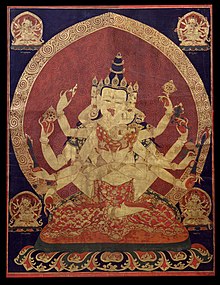Guhyasamaja
Guhyasamaja ( Tibetan གསང་བ་ འདུས་ པ Wylie gsang ba 'dus pa , English Assembly of Secrets ) is the main deity of the Buddhist tantra named after him . It is one of the oldest of this genre of mystical writings. Guhyasamaja is one of the so-called eight great Heruka gods (blood drinkers), alongside Hayagriva , Vajrakilaya , Chakrasamvara , Hevajra , Jamantaka , Amrita and Mamo . Guhyasamâja is of great importance in the schools of the new translation tradition of Tibetan Buddhism.
According to Jonathan Landaw / Andy Weber, Guhyasamaja means The Secret Gathering and / or "the King of Tantras", not only because the relevant scriptures are so old, but because they and their commentaries are the key to understanding the entire, vast spectrum of tantric literature that is generally encrypted and difficult to understand.
Goal setting
The aim of the tantras of later Buddhism (mantrayâna, vajrayâna ) is identical to that of the discourses (Sanskrit: sûtra ): liberation from this world, samsara - but the means used for this are increased: not only ethical behavior, wisdom and Meditation, but also rituals, sadhana (pictorial meditations), mantras (i.e. the recitation of words or short combinations of words), mandalas , initiations , even magical rituals and sexuality .
According to the Tibetan Buston (1290-1364), the tantras are divided into four classes: kriyâ, caryâ, yoga and anuttarayoga. The anuttarayoga tantras are divided into father [upâya, dâka, pitr, father] tantras such as the Guhyasamâjatantra, mother [prajñâ, yoginî, dâkinî, matr, mother] like the Hevajratantra, and non-dual tantras such as Kalachakra . This classification is based on the disturbing feelings with which this practice mainly works and which are transformed by it. Thus, the father tantras are aimed at practitioners with anger as the main feeling of disturbance, the mother tantras focus on attachment and the non-dual tantras focus on confusion.
Guhyasamâjatantra

Lore
It is relatively easy to date the commentaries on this tantra, but it is more difficult to date the text itself. The corpus of secondary scriptures handed down in the Tibetan Kanjur dates from the 8th to the 12th century AD.This is how it may go to date the Mahâvairocana tantra to the later 6th century, the Tattvasamgraha to the following, and the Guhyasamâja tantra to the late seventh or eighth (Wayman: Buddhist Tantras, p. 15; Gangs, p. 101). The first 17 chapters, the mûla-tantra (root tantra), are in Sanskrit, the 18th chapter as well.
text
The title could be translated as "Tantra of secret union", the last word referring to both the mystical experience and the sexual union.
The text initially describes the mandala of the deity, followed by sadhanas, i.e. pictorial meditation instructions, the hidden mandala of body, speech and mind, discourses about Buddha-nature , emptiness (Sanskrit: shûnyatâ ), the transformation of psychological poisons such as greed and hate.
As is usual in such scriptures, some passages are written in “intentional language” (Sanskrit: sandhyâ-bhâshâ ); this includes that text passages can have several levels of meaning.
Comments
Secondary, interpretative tantras such as in the Tibetan Kanjur (Tohoku catalog no. 444-447).
Candrakîrti: Pradîpoddyontana-tîkâ , which originated in the 9th century AD and offers a systematic interpretation.
Other Indian mahasiddhas who wrote about this tantra were Nagarjuna and Aryadeva .
One of the great achievements of the 11th century Tibetan master and translator Marpa was to bring Guhyasamaja's teachings from India to the snow country. Je Tsong Khapa has devoted a detailed commentary to his interpretation.
Transmission in Tibet
The Guhyasamayatantra is now specially taught in the Gelug School of Tibetan Buddhism. In addition to the tantric practice of Yamantaka, Cakrasamvara and Kalachakra, it is one of the main tantras there , but there is also a separate lineage of this tantra in the Kagyu school.
literature
- Peter Gäng: The Tantra of the Hidden Union. Guhyasamaja Tantra . Diederichs, Munich 1988, ISBN 3-424-00946-6 .
- Alex Wayman : Yoga of the Guhyasamâjatantra. The Arcane Lore of Forty Verses. A Buddhist Tantra Commentary . Motilal Banarsidass, Delhi 1999, ISBN 81-208-0872-X .
- Alex Wayman: The Buddhist Tantras. Light on Indo-Tibetan Esotericism . Motilal Banarsidass, Delhi 1993, ISBN 81-208-0699-9 .
Web links
Individual evidence
- ↑ Jonathan Landaw, Andy Weber: Images of Awakening. Tibetan art as an inner experience. Diamantverlag, 2000, p. 148 ff, ISBN 3-9805798-1-6
- ↑ Landaw / Weber 2000.